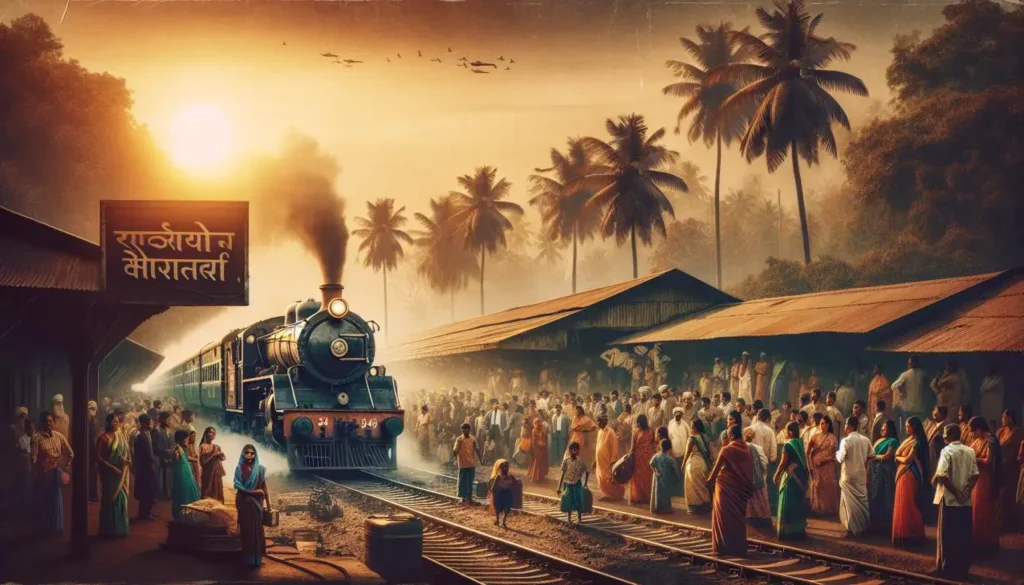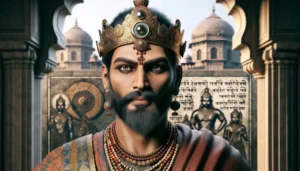Tracing the evolution of the Indian Railways is akin to exploring a pivotal chapter in India’s industrial revolution. The journey of Indian Railways began in 1853, marking a monumental milestone with the first train in India steaming its way from Bombay to Thane. Today, boasting as the fourth-largest railway network globally, Indian Railways spans over 1.2 lakh kilometers, weaving a complex tapestry of connectivity across the nation’s expanse. This historical expedition not only highlights the operational milestones, such as the establishment of the first railway station in India but also underscores the intricate relationship between the East India Company’s ambitions and the sprawling Indian railway system that emerged thereof.
As the narrative of Indian railways unfolds, the article delves into the systematic expansion and technological strides that shaped its journey from the era of the East India Company to the modern-day giant it has become. The chronological exploration encompasses key periods including the initial expansion under the British, the significant post-independence developments that followed, and the leaps towards modernization and technology-infused growth in the 21st century. From express trains zipping across the railway zones in India to the strategic planning by the Railway Board, this account is a comprehensive dive into how many trains in India chart their courses today, echoing the rich tapestry of Indian railways history from 1853 to 2013 and beyond.
The Dawn of Indian Railways (1853-1900)
Early Beginnings and Key Developments
- Formation of Railway Companies: The journey of the Indian Railways commenced with the sanction granted in 1844 allowing private entrepreneurs to build railways. This led to the establishment of pivotal entities such as the East Indian Railway Company and the Great Indian Peninsula Railway, setting the foundation of the railway network in India.
- Inauguration of the First Train: The historic first train journey in India took place on April 16, 1853, traveling from Bori Bunder in Bombay (now Mumbai) to Thane. This landmark event was attended by 400 passengers distributed among 14 carriages, marking a significant moment in Indian transportation history.
- Development of Infrastructure: The first railway workshop was set up in Jamalpur, Bihar, in 1862, which was crucial for the maintenance and repair of trains. Following this, Delhi Junction was established in 1864, becoming the oldest station in Delhi and a vital part of the northern railway network.
Expansion and Technological Innovations
- Manufacturing Milestones: A significant achievement in self-reliance was reached in 1895 when the first steam locomotive was entirely manufactured in India at the Ajmer Workshop. This milestone not only showcased indigenous capabilities but also reduced dependence on foreign manufactured locomotives.
- Introduction of Passenger Amenities: The introduction of toilets in the first-class coaches occurred in 1891, enhancing passenger comfort. However, it was not until 1907 that these facilities were extended to the lower classes, indicating a gradual improvement in amenities for all passengers.
- Network Growth: By 1880, the railway network had expanded impressively to about 14,500 kilometers, primarily radiating from the three major port cities: Bombay, Madras, and Calcutta. This expansion facilitated enhanced trade and mobility, significantly impacting India’s economic landscape.
Impact on Productivity and Economic Growth
- Productivity Growth Under British Raj: Between 1874 and 1912, Indian Railways experienced substantial productivity growth, unlike other sectors of the Indian economy. New estimates using railway-level data on outputs and inputs indicate that total factor productivity (TFP) grew by an average of 2.0 to 2.6 percent annually.
- Contribution to GDP: The growth in TFP on the railways accounted for approximately 12 percent of the increase in Indian GDP per capita during this period, underscoring the significant economic impact of the railways.
- Technological and Operational Improvements: The focus on capacity utilization and technological advancements played a crucial role in enhancing the efficiency and effectiveness of the railway system during this era.
Challenges and Government Intervention
- Famine Relief and Government Control: From 1869 to 1881, the British Raj intensified its control over railway construction, significantly increasing expansion efforts to aid regions affected by famine. This period saw a strategic shift in the management and expansion of the railway network to address immediate societal needs.
- Early Passenger Travel Funding: Initially, the funding for passenger travel was primarily sourced from private companies under a guarantee system created by the British Parliament. This approach facilitated the early expansion and operational management of passenger trains in India.
This period in the history of Indian Railways not only highlights the technological and operational advancements but also reflects the socio-economic transformations spurred by the expanding railway network. The developments during these formative years laid the groundwork for what would become one of the world’s largest and most complex railway systems.
Expansion and Evolution (1901-1947)
Establishment of the Railway Board and Expansion of Rail Networks
In 1901, the Railway Board was established under the Department of Commerce and Industry, marking a significant shift in the administrative control of the Indian Railways, with powers still vested in the Viceroy. This period also saw the railway network reaching approximately 14,500 km, primarily extending from the major port cities of Bombay, Madras, and Calcutta, which played a crucial role in enhancing regional trade and connectivity.
Technological Innovations in Railways
The early 20th century was marked by several key technological advancements in the Indian Railway system:
- Introduction of Electric Lighting: In 1902, the Jodhpur Railway Department became the first to introduce electric lighting as standard fixtures, setting a precedent for other zones.
- Adoption of Electric Signal Lighting: By 1920, electric signal lighting was introduced between Currey Road and Dadar in Bombay, enhancing safety and efficiency in train operations.
- Inauguration of the First Electric Train: The first electric train in India commenced operations in 1925, running between Victoria Terminus and Kurla Harbour, symbolizing the beginning of electric traction in Indian railways.
Iconic Trains and Routes
- The Kalka Shimla Railway (KSR): This route was joined in 1903 and later became a significant attraction due to its scenic beauty and engineering marvels.
- The Nilgiri Mountain Railway: Originally opened in 1899 and extended to Ooty in 1903, it was accorded World Heritage Status in 2005, recognizing its historical and cultural significance.
- The Deccan Queen: Launched in 1930, this train connected Pune and Mumbai and became famous for its speed and services, enhancing the connectivity between Maharashtra’s major cities.
Challenges and Milestones
The period also witnessed significant challenges and milestones:
- Partition Impact: The departure of Britain in 1947 resulted in the loss of over 40% of the railway network to the newly created Pakistan, which posed logistical and operational challenges.
- Introduction of Diesel and Electric Traction: Although the first diesel locomotive was used in 1954, the groundwork for diesel and electric traction was laid during this era, with the adoption of 25 kV AC traction occurring in 1957, paving the way for modernization of the Indian railway fleet.
The expansion and evolution of the Indian Railways from 1901 to 1947 not only involved growth in infrastructure and network but also significant technological advancements that set the stage for future developments in the Indian railway system.
Post-Independence Developments (1947-1980)
Nationalization and Zonal Reorganization
In the wake of independence in 1947, Indian Railways underwent significant changes, beginning with its nationalization in 1951. This pivotal move led to the integration of various regional systems into a single entity, marking a new era of centralized administration. The reorganization into zones was a strategic response to manage the network more efficiently. By 1952, the Indian Railways was divided into six regional zones: Southern, Central, Western, Northern, Eastern, and North Eastern, each responsible for specific geographical areas, thereby streamlining operations and management.
Technological Advancements and Infrastructure Expansion
The post-independence era saw substantial efforts to expand the railway network and introduce new technologies. The total route length of Indian Railways was approximately 52,000 km by 1960, expanding to about 60,000 km by 1980. This expansion included the introduction of the first electric passenger train in 1962 and significant strides in electrification, with around 4,500km of track electrified between 1980 and 1990. The adoption of 25 kV AC traction in 1957 further modernized the railway system, enhancing the efficiency of train operations across the network.
Introduction of Iconic Trains and Services
The period also witnessed the introduction of iconic services that would define Indian Railways’ passenger service. In 1969, the first Rajdhani Express was flagged off, connecting New Delhi to Howrah and representing a significant leap in terms of speed and comfort in Indian rail travel. The introduction of containerized freight transport in 1966 between Bombay and Ahmedabad marked the beginning of modern freight handling in India, significantly boosting the efficiency of cargo movement.
Focus on Speed and Efficiency
Efforts to increase the speed of passenger trains were also evident, with a study commissioned in 1960 aiming to increase speeds to 160 km/h. By 1980, the WAP-1 electric locomotives were achieving speeds of 130 km/h, showcasing Indian Railways’ commitment to enhancing passenger travel experience. The phase-out of steam locomotives during the 1980s, spurred by the global energy crises, marked the end of an era and the beginning of a more sustainable and efficient electrified railway system.
Cross-Border Connectivity and Cultural Impact
In a significant move towards international connectivity, the first train between India and Pakistan, the Samjhauta Express, began operations in 1976, running between Amritsar and Lahore. This service not only enhanced cross-border travel but also served as a cultural bridge between the two nations.
Modernization Efforts
The 1970s were marked by continued modernization efforts within Indian Railways. The introduction of the Kolkata Metro in 1971 as the first metro rail system in India was a landmark in urban transport, providing a rapid transit system to one of the country’s most populous cities. This period also saw the introduction of more advanced diesel locomotives, with the first diesel locomotive fabricated by North British Locomotive Company in 1954, setting the stage for a gradual transition to more robust and efficient traction systems.
These developments from 1947 to 1980 not only reflect the technological and operational advancements of Indian Railways but also highlight the socio-economic transformations spurred by these changes, significantly impacting India’s growth and development during this period.
Technological Advancements and Modernization (1981-2000)
Electrification and Expansion of Track
Between 1980 and 1990, Indian Railways embarked on an extensive electrification project, adding approximately 4,500 kilometers of electrified track. This initiative significantly enhanced the efficiency and capacity of the rail network, supporting faster and more environmentally friendly train services.
Introduction of Metro Systems and Elevated Railways
- Calcutta Metro: In 1984, India witnessed the inauguration of its first metro system in Calcutta, marking a significant milestone in urban mass transit.
- Chennai MRTS: By 1995, Chennai introduced the first operational elevated railway line in India, setting a precedent for other cities to enhance urban connectivity.
Innovations in Passenger Services
Computerized Ticketing and Reservations
In a leap towards modernizing customer service, 1986 saw the introduction of computerized ticketing and reservations. This system was gradually implemented across major cities including Delhi, Madras, Bombay, and Calcutta, culminating in a nationwide network known as CONCERT in 1995, which streamlined the booking process across the country.
Introduction of Shatabdi Express
1988 marked the launch of the first Shatabdi Express, designed as a day train that offered quick connectivity between major cities, combining speed with luxury.
Enhancements in Comfort and Accessibility
In 1993, Indian Railways introduced air-conditioned three-tier coaches and sleepers, significantly improving comfort for long-distance travelers.
Strategic Infrastructure Developments
Konkan Railway
The 1990s witnessed the completion of the Konkan Railway, a 738-kilometer track that linked the western coast of India with major industrial hubs, enhancing economic and logistic capabilities.
Administrative and Policy Milestones
- Establishment of the South East Central Railway Zone: In 1999, this new railway zone was created to optimize operations and management in the region.
- First Live Telecast of the Rail Budget: 1994 saw the first live broadcast of the Rail Budget, increasing transparency and public engagement in railway administration.
- Historic Leadership: In 2000, Mamta Banerjee became the first woman to hold the post of Railway Minister, marking a significant moment in the history of Indian Railways.
These advancements during the period from 1981 to 2000 not only reflect significant technological strides but also highlight efforts towards modernizing the Indian railway system to meet the demands of a growing economy and a diverse population.
Indian Railways in the 21st Century
Strategic Goals and Financial Commitments
The Indian Railways has embarked on an ambitious journey to transform its services and infrastructure by the end of the decade. With a substantial al__cpLocation of Rs 14 trillion, the focus is on expanding passenger capacity to accommodate 10 billion passengers annually by 2030. This strategic financial injection aims to eliminate waiting lists and significantly increase the efficiency of both passenger and cargo transport. The government’s proactive approach also includes capturing nearly half of the anticipated 3,000 million tonnes of cargo expected over the next ten years.
Technological Integration and Smart Solutions
The future of Indian Railways is tightly interwoven with advanced technology and smart solutions. The railways are poised to harness the potential of artificial intelligence and data analytics to optimize operations. This technological leap will facilitate data-driven approaches, enabling targeted marketing and dynamic pricing models to drive revenue. Additionally, the emphasis on safety and the adoption of world-class signaling technology are top priorities to enhance operational efficiency and passenger security.
Domestic Production and Global Aspirations
A significant shift towards self-reliance is evident as the Indian Railways plans to increase the domestic production of locomotives. The initiative includes the operational rollout of Vande Bharat trains, with an eye towards exporting these models once they are established within the country. This move not only aims to bolster the domestic manufacturing sector but also positions Indian Railways as a key player in the global rail industry.
Infrastructure Development and Modernization
The Ministry of Railways is focused on overcoming infrastructure challenges through comprehensive technological advancements and efficient financial management. The development of an integrated Enterprise Resource Planning (ERP) system and the expansion of freight traffic via dedicated freight corridors are part of this vision. Additionally, the construction of high-speed rail lines, such as the Mumbai-Ahmedabad corridor financed by Japan’s International Cooperation Agency (JICA), highlights the significant capital investments required to achieve these modernization goals.
Partnerships and International Collaboration
Collaborations with multinational corporations and major financial institutions like the World Bank, Life Insurance Corporation of India (LIC), and the Indian Railway Finance Corporation are crucial in reshaping the Indian Railways. These partnerships not only provide the necessary capital but also bring in global expertise to streamline operations and enhance service delivery.
Environmental Initiatives and Sustainability Goals
Indian Railways is setting a benchmark in environmental responsibility by aiming to meet 25% of its power needs through renewable sources by 2025. The ultimate goal is to achieve net-zero carbon emissions by 2030, reflecting a strong commitment to sustainable development. Initiatives such as the introduction of India’s first solar-powered train and the complete switch of Western Railway to AC traction are steps towards this sustainable vision.
Expansion and Service Enhancement
The recent years have seen the introduction of several landmark services that redefine travel by rail in India. These include the launch of the Vande Bharat Express, India’s fastest train, which represents a significant leap in terms of speed and passenger comfort. The expansion of free WiFi services across over 7,000 stations and the rollout of solar and CNG-powered trains further illustrate Indian Railways’ commitment to enhancing passenger experience while adhering to environmental standards.
Indian Railways’ journey through the 21st century is marked by a blend of ambitious expansions, technological revolutions, and a steadfast commitment to sustainability. These efforts are not only enhancing the travel experience but are also setting new standards in railway operations globally.
Frequently Asked Questions
Q: Can you tell me about the Indian Railways documentary available on Netflix?
A: The documentary on Netflix focuses on the heroic efforts of Indian railway workers who risked their lives to save others during a catastrophic gas leak in Bhopal, highlighting their bravery in the face of a terrible disaster.
Q: What significant event occurred on April 16, 1853, in the context of Indian Railways?
A: The inaugural journey of India’s first passenger train took place on April 16, 1853, traveling from Bori Bunder (Bombay) to Thane, covering 34 kilometers. This historic event featured three locomotives—Sahib, Sultan, and Sindh—pulling a convoy of thirteen carriages.
Q: Could you provide a brief history of the Great Indian Peninsula Railway (GIPR)?
A: The GIPR marked its beginning on April 16, 1853, with a celebratory train carrying 400 guests in 14 carriages from Bombay to Thane. Propelled by three engines named Sindh, Sultan, and Sahib, the 21-mile (34 km) journey was completed in one hour and fifteen minutes, signifying the first operational section of the GIPR and the dawn of passenger railway service in India.
Q: Which was the first railway line to be established in Kerala?
A: Kerala’s railway history commenced with the opening of the line from Beypore to Tirur on March 12, 1861. This line holds the distinction of being the first in the state, and Tirur continues to be a significant stop on the proposed high-speed rail project.



